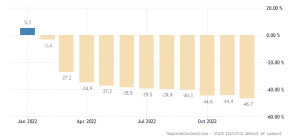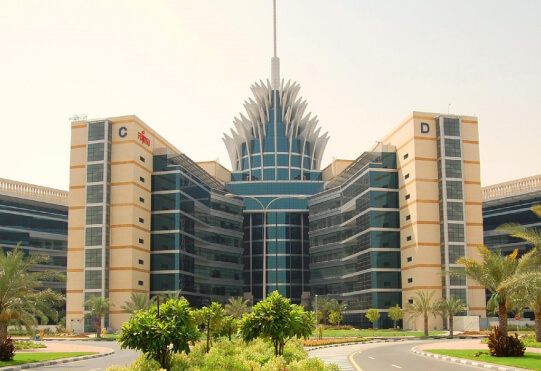The Russian invasion of Ukraine has sent shockwaves through Ukrainian and global businesses, particularly in the energy, raw materials, and logistics sectors. Manufacturers quickly experienced the consequences of the war, including blocked sea routes, destroyed or mined ports, bombed rail connections, and damaged manufacturing facilities.
Prior to the war, Ukrainian manufacturers accounted for 42% of the country’s exports, second only to the agricultural sector, which held a 46% share [1]. The majority of these exports consisted of raw materials and semi-finished products. Ukraine primarily exported goods to the European Union (39%), China (12.1%), Turkey (6.1%), and Russia (5.1%) [1]. However, following the war, there has been a shift in export destinations, with the European Union accounting for 63% of exports, as reported by Prime Minister Shmyhal [2].
The war has caused a significant decline in manufacturing production in Ukraine, with a 46.70% decrease in December 2022, as compared to the same month the previous year [3]. While security concerns and destruction played significant roles in this decline, the distribution of regional supply chains also contributed to the production drop.


Manufacturing Production in Ukraine in 2022 [3]
Many Ukrainian manufacturing sites were previously part of larger holdings, located in industrial clusters, or situated close to raw-material suppliers. This setup aimed to keep supply chains shorter and more cost-effective to manage. For example, the Poltava region housed numerous agricultural and food processing industrial sites. Typically, raw materials were sourced from regional producers, processed within the region, and distributed through trucks, sea, or rail for domestic and international markets.
During times of war, securing energy sources becomes a major obstacle to supply chains. Industrial enterprises have limited – or no – options to replace natural gas with alternative energy resources, due to the substantial investments required. As a result, the persistently high global gas prices pose a risk of business closures, particularly in energy-intensive industries. This leads to increased producer prices and reduced state budget revenues.
The destructive impact of Russian troops on the logistics infrastructure has severed supply chains within Ukraine, making it impossible to export finished goods. For instance, the Russian occupiers’ blockade of the Black Sea ports hinders the export of 80-90% of industrial goods. Reorienting cargo transportation from waterways to land routes is challenging, due to the significant increase in logistics costs and the inadequate capacity of railways and roads. The same problems persisted with the imports, yet the issues of security made it even harder to deliver imports. The heightened risk made it exceedingly challenging to engage logistics companies willing to operate within the country, as many insurance companies were reluctant to provide coverage for transportation heading to Ukraine.
The Black Sea Grain Deal, facilitated by Turkey and the United Nations in July 2022, had partially unblocked the major Ukrainian sea ports for critical grain exports. Though continuous threats by Russia to withdraw from the agreement, as well as frequent violations of the commitments from aggressor’s side blocking or slowing down the inspection of the Ukrainian vessels, push Ukrainian traders to look for alternative transportation routes.
To rebuild their supply chains, manufacturing businesses can employ several strategies. Firstly, they must embrace the fact that they are operating under uncertainty during times of war, and they must exercise flexibility and agility to adapt swiftly to changing circumstances. Secondly, rather than relying on stocking up inventory, which carries the risk of loss due to the volatile situation in Ukraine, companies should focus on diversifying their supply base. Engaging multiple suppliers from different regions reduces dependence on a single source and mitigates the risk of disruptions. Thirdly, changing transportation routes and altering the form of the product can be effective. For example, in the agriculture sector, producers can shift from bulk grain exports to producing flour or selling prepackaged grain, enabling alternative transportation methods and expanding market opportunities. Furthermore, given the rapidly evolving conflict, changing transportation routes may become necessary, as certain routes become dangerous overnight. Lastly, rerouting logistics can help companies avoid conflict zones and ensure uninterrupted supply chain operations. By identifying alternative transportation routes and collaborating with experienced logistics providers in navigating challenging environments, businesses can minimize disruptions and maintain continuity.
In addition to the restructuring efforts on the export side of the supply chain, the import aspect holds great importance, presenting opportunities for international businesses to engage. The principles of supply diversification and logistics rerouting also apply to imports, but there are additional avenues for creating value. These include providing technology and innovation, such as digitizing logistics optimization or storage efficiency, contributing to infrastructure development, establishing investment and trade agreements that offer financial incentives, and offering sector-specific solutions like renewable energy development. As Ukraine aims to reduce its reliance on Russian energy exports in the European market, the significance of these solutions continues to grow. Several governments, including Germany and Denmark, have already signed agreements to support the development of renewable energy infrastructure in Ukraine, while private companies are actively involved in constructing wind farms and biomethane plants.
Government involvement plays a crucial role in supporting businesses navigating the challenges of supply chain restructuring in Ukraine. While seaports remain blocked, the government is focusing on facilitating alternative transportation options, such as road and rail, to ensure businesses can continue exporting. International governments have provided financial incentives and trade agreements to promote stability and encourage investment in the region. The Ukrainian government, in particular, offers grants to businesses relocating to safer regions, encouraging the diversification of production sites. Additionally, the implementation of e-queue and e-declarations systems expedites border crossings into Europe, facilitating smoother trade flows. Efforts are underway to expand and develop border checkpoints on western, western-southern, and railway corridors to improve the transshipment of goods. Although discussions on opening ports for non-grain exports are receiving pushback due to Russia’s disruptive actions, the government continues to explore possibilities. Furthermore, improvements in cluster legislation aim to create an environment in which businesses can collaborate and leverage synergies for supply chain optimization.
Apart from the national government, the European Bank for Reconstruction and Development is among the many international organizations that assisted Ukraine during the war. Its EU-Ukraine Solidarity Lanes project focuses on improving connectivity between the two partners by opening up alternative trade corridors [4]. The U.S. Agency for International Development (USAID) also takes part in debottlenecking Ukrainian grain exports through the Izmail and Reni ports in Ukraine, both on the Danube and Čierna nad Tisou in Slovakia [5].
Early on, Ukrainian companies and international companies in Ukraine started to show glimpses of how to successfully restructure supply chains amidst a war. For instance, the two Ukrainian companies, one in agriculture, another in the oil & gas sector, recently joined the new Mostysky Dry Port industrial park in the Lviv region [6]. The companies there deal with debottlenecking export capacities by building new storage facilities, extending both the narrower European track to Ukraine and the Ukrainian track to create a transshipment point to quicken exports to the EU. Moreover, the Ukrainian Maritime Cluster actively develops the opportunities of river navigation and small-scale shipments in the south of Ukraine, also with a primary reason to increase exporting capacities of the country [7].
Needless to say, individual companies have also managed to successfully overcome the challenge without joining industrial parks or clusters. Centravis, a stainless steel pipe manufacturer based in Nikopol, is one such example. Before the Russian invasion, Centravis primarily exported products through Ukrainian ports. However, anticipating potential disruptions, the company swiftly redirected its export deliveries to European ports a few weeks before the invasion occurred [8]. The new route, albeit more expensive, allowed Centravis to maintain delivery schedules despite the pre-war uncertainties. The logistics costs doubled, but the company had to assure its clients of its capability to ensure stable shipments. Moreover, Centravis narrowed down its product line to focus on the most profitable items, such as instrument tubing ranging from 6 mm to 26 mm in diameter, which are utilized in fuel supply systems, brake systems, chassis, and other applications. In February 2023, Centravis resumed its pre-war production capacity. To diversify risks, the company established an alternative production facility in Uzhhorod for manufacturing fuel system tubing. This €2.7 million investment comprises a workforce of 100 employees and accounts for 10% of the capacity of the main plant in Nikopol. Initially conceived as a partial relocation, this project has now become supplementary to the primary production operations.
Ukrainian and foreign businesses have demonstrated resilience and adaptability by implementing strategies to rebuild their supply chains. Embracing uncertainty, diversifying the supply base, changing transportation routes and product forms, and rerouting logistics have been key approaches taken by manufacturers. The Ukrainian government’s involvement and the involvement of international communities have played crucial roles in facilitating alternative transportation options, providing financial incentives, and streamlining border crossings.
The efforts of Ukrainian businesses exemplify their determination to navigate challenges and find new growth opportunities amidst conflict, ensuring continuity in production and export operations.
****
The material was prepared by Nina Kurochka, Account Executive at CFC Big Ideas.



